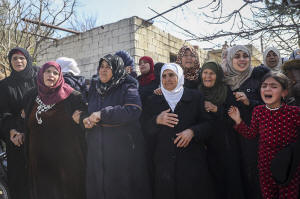Syria's worst violence in months reopens wounds of the civil war
[March 10, 2025]
By KAREEM CHEHAYEB
An ambush on a Syrian security patrol by gunmen loyal to ousted leader
Bashar Assad escalated into clashes that a war monitor estimates have
killed more than 1,000 people over four days.
The attack Thursday near the port city of Latakia reopened the wounds of
the country’s 13-year civil war and sparked the worst violence Syria has
seen since December, when insurgents led by the Islamist group Hayat
Tahrir al-Sham, or HTS, overthrew Assad.
The counteroffensive against the Assad loyalists in the largely Alawite
coastal region brought havoc to several cities and towns. Rights groups
reported dozens of revenge killings resulting from Sunni militants
targeting the minority Islamic sect, regardless of whether they were
involved in the insurgency.
Here’s a look at the latest violence in the war-wracked country:
What started the violence?
Tensions have been on the rise since Assad's downfall following
sectarian attacks against Alawites, who ruled Syria for over 50 years
under the Assad dynasty. The assaults continued despite promises from
Syria’s interim president that the country's new leaders will carve out
a political future for Syria that includes and represents all its
communities.
In their ambush, the pro-Assad Alawite gunmen overwhelmed government
security forces and later took control of Qardaha, Assad's hometown, as
Damascus scrambled to bring in reinforcements.
Defense Ministry spokesperson Col. Hassan Abdel-Ghani said Sunday that
security forces have restored control of the region and will continue
pursuing leaders of the galvanized insurgency.

But despite authorities calling for an end to the sectarian incitement,
the clashes turned deadly, and many civilians were killed.
Who are the dead?
Most of the dead are apparently members of the Alawite community, who
live largely in the country's coastal province, including in the cities
of Latakia and Tartous. Rights groups estimate that hundreds of
civilians were killed.
The Alawite sect is an offshoot of Shia Islam, and it once formed the
core constituency of Assad's government in the Sunni-majority country.
Opponents of Assad saw Syria under the family's rule as granting
privileges to the Alawite community. As the civil war intensified,
militant groups emerged across the country and treated Alawites as
affiliates of Assad and his key military allies, Russia and Iran.
Syria's new interim government is under Sunni Islamist rule. Interim
President Ahmad Al-Sharaa, a former HTS leader, has promised that the
country will transition to a system that includes Syria's mosaic of
religious and ethnic groups under fair elections, but skeptics question
whether that will actually happen.
Little is currently known about the Alawite insurgency, which is
composed of remnants of Assad's web of military and intelligence
branches, and who their foreign backers might be.

[to top of second column]
|

Relatives and neighbours mourn during the funeral procession for
four Syrian security force members killed in clashes with loyalists
of ousted President Bashar Assad in coastal Syria, in the village of
Al-Janoudiya, west of Idlib, Saturday, March 8, 2025. (AP Photo/Omar
Albam)

Why were the Alawites targeted?
The Syrian Observatory for Human Rights said 745 civilians killed,
mostly in shootings. In addition, 125 members of government security
forces and 148 militants with armed groups affiliated with Assad
were killed. Electricity and drinking water were cut off in large
areas around Latakia, the group added.
Meanwhile, the Syria Campaign and the Syrian Network for Human
Rights, which both advocated against Assad after the civil war began
in 2011, said Saturday that both security forces and pro-Assad
gunmen were “carrying out mass executions and systematic killings.”
The SNHR estimated that 100 members of the government's security
forces were killed Thursday, while 125 of an estimated 140 civilians
were slain over the weekend in “suspected revenge killings.”
The Associated Press could not verify those numbers, and conflicting
death figures during attacks in Syria over the years have not been
uncommon. Two residents in the coastal region said that many homes
from Alawite families were looted and set on fire. They spoke from
their hideouts on condition of anonymity, fearing for their lives.
Damascus blamed “individual actions” for the widespread violence
against civilians and said government security forces were
responding to the gunmen loyal to the former government.
Can Damascus restore calm after the clashes?
Damascus has struggled to reconcile with skeptics of its Islamist
government, as well as with Kurdish-led authorities in the northeast
and the Druze minority in the south. Al-Sharaa has lobbied to
convince the United States and Europe to lift sanctions to pave the
way for economic recovery to pull millions of Syrians out of poverty
and make the country viable again.
Washington and Europe are concerned that lifting sanctions before
Syria transitions into an inclusive political system could pave the
way for another chapter of autocratic rule.
Al-Sharaa appealed to Syrians and the international community in an
address over the weekend, calling for accountability for anyone who
harms civilians and mistreats prisoners. Such human rights
violations were rampant under Assad. Blaming remnants of the former
government for the outbreak of violence, and certain foreign parties
supporting them, Al-Sharaa also formed a committee composed mostly
of judges to investigate the violence.
In a statement issued Sunday, U.S. Secretary of State Marco Rubio
urged Syrian authorities to “hold the perpetrators of these
massacres" accountable. Rubio said the U.S. “stands with Syria’s
religious and ethnic minorities, including its Christian, Druze,
Alawite, and Kurdish communities.”
All contents © copyright 2025 Associated Press. All rights reserved |